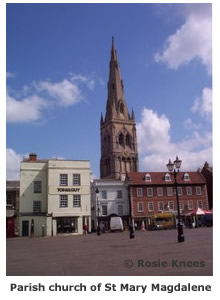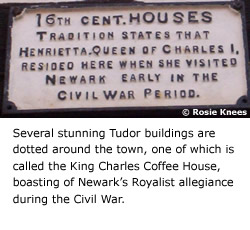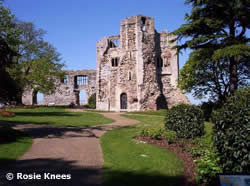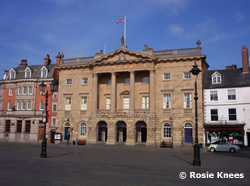Newark on Trent – Historic Market Town’, lies on the banks of the River Trent, and with the A1 and A46 running through it, is also know as ‘The Gateway to The North’.

The A46 lies along the route of what was the Roman road from Lincoln to Exeter, the Fosse Way, and Roman remains have been found in many villages around Newark.
It is not known whether there was actually any Roman settlement at Newark, but there is no doubt that those feet would have passed through what is now my place of work. The Romans left these shores in around AD400.
If there was no Roman settlement in Newark, there were certainly Anglo-Saxons living here. An Anglo-Saxon cemetery, used from the early 5th to the early 7th centuries, has been found in Millgate which runs close to the Fosse Way.
The famous Lady Godiva is known to have owned Newark in 1055, and in 1086, ‘Newerche’ is mentioned in the Doomsday Book as having a population of 117 people; this rising to around 35,000 by 2007.

There are many places of worship of different denominations in Newark. However, the town is dominated by the towering spire of the parish church of St Mary Magdalene which is about 250 feet high and is reputed to be the fifth tallest parish church tower in the country.
There are many buildings in Newark of stunning architectural merit; the oldest of which now houses the Nottingham Building Society. It was originally a house and became the White Hart Inn. It was one of the most important inns in the town during the Civil War and the town’s busiest coaching inn during the 1830s, and dates from the 15th century.
Several stunning Tudor buildings are dotted around the town, one of which is called the King Charles Coffee House, boasting of Newark’s Royalist allegiance during the Civil War.

During the English Civil War Newark’s allegiance lay with King Charles I and was a Royalist stronghold. What is now the ‘Baker’s Oven’, pictured in the montage of Tudor buildings on the front page of this issue, is the place where Prince Rupert stayed overnight in October 1645, as it was the Governor’s house during the Civil War.
Newark was laid siege to three times by Oliver Cromwell’s Roundheads in 1643, 1644 and 1646. The siege of 1646 lasted six months, before Charles surrendered on 5th May. With the town being besieged so regularly it was apparently felt necessary to strike ‘siege coins’, an illustration of which can be seen here: Nottinghamshire Heritage Gateway.

Newark Castle was built on the banks of the River Trent in the 12th century by Alexander the Magnificent. It is famous for being the place where King John died in 1216 and where, in 1603, James I stayed en-route to being crowned King. After the end of the Civil War, when Charles I had surrendered, the castle was destroyed on the orders of Oliver Cromwell; presumably as it had been the cause of much trouble for him, having laid siege to the town three times in four years.
The cobblestones of Newark Market Place are watched over by the magnificent town hall. It was designed by John Carr of York and built between 1774-1776. Newark’s police station was, at one time, located on the right hand side of the town hall, the blue door there being the entrance. On the left hand side of the building can be seen the narrowest building in the town, at just one room wide over three floors.

The brewing of beer is a huge part of Newark’s past and two large breweries, John Smith’s and Warwick’s and Richardson, used to supply their beer to local pubs which refreshed the working men of Newark and the East Midlands. There are many old maltings and malt kilns dotted around the town, most of which are now listed for protection and some have been tastefully renovated into apartments.
Newark had many coaching inns which played a large part in keeping the Royal Mail coaches on the move by stabling the horses. Sadly, the coaching era in Newark, as in most of the country, died out almost overnight with the introduction of the railways. Newark has two railway stations; Castle station which accommodates the east/west railway and Northgate station which is a major station for the main east-coast railway, each helping the town to retain its title ‘Gateway of the North’.
Rosie Knees
© Rosie Knees 2008